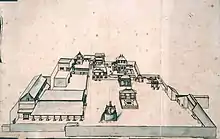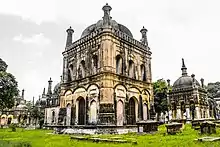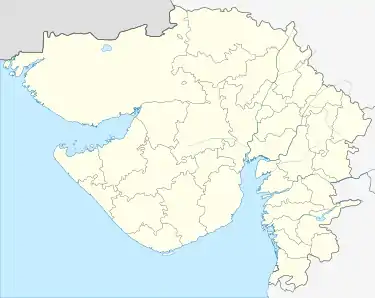Dutch Suratte
Suratte or Soeratte was a directorate of the Dutch East India Company between 1616 and 1795, with its main factory in the city of Surat. Surat was an important trading city of the Mughal Empire on the river Tapti, and the Portuguese had been trading there since 1540. In the early 17th century, Portuguese traders were displaced by English and Dutch traders.
Dutch Suratte Suratte | |||||||||
|---|---|---|---|---|---|---|---|---|---|
| 1616–1825 | |||||||||
 Flag
 Coat of arms
| |||||||||
| Status | Dutch colony | ||||||||
| Capital | Surat | ||||||||
| Common languages | Dutch | ||||||||
| Director | |||||||||
• 1620–1628 | Pieter van den Broecke | ||||||||
• 1673–1676 | Willem Volger | ||||||||
• 1699–1701 | Hendrick Zwaardecroon | ||||||||
• 1729–1740 | Pieter Phoonsen | ||||||||
• 1818–1825 | Conrad Josef Gustaf van Albedyll | ||||||||
| Historical era | Imperialism | ||||||||
• Establishment of a trading post at Suratte | 1616 | ||||||||
• Handover to the British according to the Anglo-Dutch Treaty of 1824 | 21 December 1825 | ||||||||
| |||||||||
Due to internal unrest in the Mughal Empire, Surat's trade with the Mughal capital of Agra gradually declined in the early 18th century, with most trade shifting to Bombay, the new capital of the English Western Presidency. The city became part of British India as a consequence of the Third Carnatic War (1756–1763).[1] While traders of the Dutch East India Company continued trading in Surat, they had become subordinate to the English.[2]
The Dutch possessions in Surat were occupied by British forces in 1795 by instruction of Dutch stadtholder William V, who wanted to prevent revolutionary France from taking possession of the Dutch holdings in Asia. It was restored to the Dutch in 1818, but again ceded to the English in 1825, owing to the provisions of the Anglo-Dutch Treaty of 1824.
History



Pieter van den Broecke established a Dutch trading post in Suratte in 1616, after previous efforts had failed in the years before. The Dutch East India Company was compelled to form this post after the sultan of Aceh no longer allowed them to buy cheap cotton on the local market. In 1668, Dutch and English traders were joined by the French, who established their first trading post on the Indian subcontinent there.
In 1691, Hendrik van Rheede, administrator of the Dutch East India Company, died on his way from Kochi in Dutch Malabar to Suratte. He was buried with much pomp and circumstance on the Dutch-Armenian cemetery of Surat.
By 1759, the Dutch East India Company's trade had fallen substantially. Trade had largely moved to British Bombay, with Suratte playing only a subordinate role. Due to the provisions of the Kew Letters, Dutch Suratte came under English protection in 1795, who promised to restore it to the Dutch upon the restoration of peace in Europe.[1] Initially, the English allowed the Dutch to continue their trade and even permitted them to fly the Dutch flag on their factories, but in February 1797, the English flag replaced the Dutch flag, and three months later, the last Dutch military forces left the city.[3]
The Treaty of Amiens of 1802 was supposed to restore Dutch Suratte to Dutch rule, leading the Dutch to send a commission under the leadership of Carl Ludwig Maximilian van Albedyll to take possession of the Dutch factory in Suratte. However, before Suratte could be restored to the Dutch, hostilities in Europe had resumed, and Van Albedyll and his company were made prisoners of war on 30 August 1803. Van Albedyll died less than a year later while still imprisoned, on 12 August 1804.[4]
When the Anglo-Dutch Treaty of 1814 again restored the Dutch possessions in Suratte to Dutch rule, Van Albedyll's son Conrad Josef Gustaf van Albedyll, who had traveled to Surat as part of the commission under the leadership of his father, was installed as the new resident of Dutch Suratte on 1 May 1818.[5] He remained in office until Dutch Suratte was again relinquished to the British by the Anglo-Dutch Treaty of 1824, which divided East Asia into Dutch and British spheres of influence.
Legacy

Surat still has a Dutch-Armenian cemetery, which features the mausoleum of Hendrik van Rheede. Bharuch has remnants of the Dutch lodge and a Dutch cemetery.[6][7] Agra features a mausoleum for Jan Willem Hessing (1739–1803), a Dutch soldier who became a military adviser to Maharaja Mahadaji Shinde.[8]
Trading posts

| Settlement | Type | Established | Disestablished | Notes |
|---|---|---|---|---|
| Suratte | Factory | 1616 | 1825 | Founded by Pieter van den Broecke in 1616. After the British took the city of Suratte from the Mughal Empire in 1759, the trading post's role diminished. Eventually relinquished to the British in the Kew Letters and temporarily restored to the Dutch between 1818 and 1825. |
| Ahmadabad | Factory | 1617 | 1744 | Important trading port. The Dutch East India Company office was founded in 1617 and eventually abandoned in 1744. |
| Agra | Factory | 1621 | 1720 | Capital of the Mughal Empire. Due to the remote location of six weeks travel from Suratte, the trading post was almost never visited by inspectors of the Dutch East India Company. Private trading (forbidden by the Dutch East India Company) and corruption made traders here rich men. |
| Cambay | Factory | 1617 | 1643 | Rather unsuccessful post due to the inability of ships to dock at the port at low tide. After problems with local merchants closed in 1643. |
See also
Notes
- Van der Kemp 1901, p. 409.
- De VOC site - Suratte
- Van der Kemp 1901, p. 410.
- Van der Kemp 1901, pp. 410-411.
- Van der Kemp 1901, p. 416.
- "Bharuch: Dutch sundial in 2019". dutchindianheritage.net. Retrieved 23 September 2020.
- "Bharuch revisited in 2019". dutchindianheritage.net. Retrieved 23 September 2020.
- "Agra: Jan Willem Hessing's 'Red Taj'". dutchindianheritage.net. Retrieved 23 September 2020.
References
- Van der Kemp, P.H. (1901). "De Nederlandsche factorijen in vóór-Indië in den aanvang der 19e eeuw". Bijdragen tot de Taal-, Land- en Volkenkunde. 53 (1): 286–507. doi:10.1163/22134379-90002075.